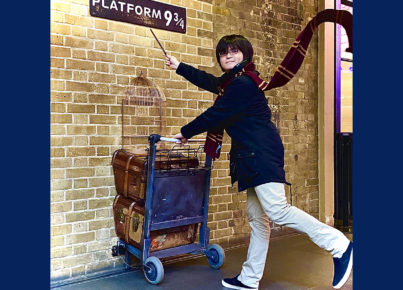“A Greener Future for All”
Lei Zemin
University student (Major in Applied Mathematics)
Singapore
It has been a year with calamities. Gloom hangs over the overcast sky, and despair fills the hearts of many who look out longingly of their windows, searching for a glimpse of hope. Nature is mercilessly striking back, responding to Man’s provocations with fury and force. Too many ill-boding headlines flood the newspapers: “2020 one of three hottest years ever recorded: UN”, “Ominous orange sky gives San Francisco apocalyptic tint”, and so on. As if things are not bad enough, all of these are happening in the midst of an ongoing pandemic that has taken lives and destroyed livelihoods. In the grimmest way, Nature is warning us of the wrath that awaits us if we continue to aggravate it. Even though the future remains uncertain, one thing is for sure: this is only the beginning. It will only get worse if we do not take collective action to combat the climate crisis. Unfortunately, this is not a problem that we can just sweep under the carpet and conveniently forget about it. The only way forward is acknowledging the threat of climate change and accelerating the development and adoption of green technology. The following is the future that I envision:
- Renewable energy: The world goes coal-free as coal is completely replaced by renewables such as wind and solar energy.
- Hydrogen and electric vehicles: Traditional gas and diesel vehicles will be completely replaced by hydrogen and electric vehicles.
- Green buildings: All buildings must meet ‘green’ requirements.
- Plant-based and lab-based meat: Consumption of ‘real’ meat will drastically decrease as consumers adopt plant-based and lab-based meat.
- Decarbonising the fashion industry: Reduce carbon emissions to zero.
In order for these changes to take place, we will need governments, businesses, consumers, financial institutions and investors to work together. I definitely do think that governments need to give carbon-neutral tax incentives to offset possible concerns that businesses may have about increased costs due to carbon neutrality initiatives. Also, governments can impose carbon taxes to discourage carbon-emitting business practices. At the same time, businesses must exercise corporate responsibility and leverage the tax incentives to deliver carbon neutrality initiatives and innovations. As for consumers, they can vote for the society that they want to see with their wallets. Beyond consumption, sustainable financing is also equally important, and this is where financial institutions and investors come into the picture. Financial institutions such as banks should preferentially grant loans to businesses with carbon neutrality projects. Investors should also invest more actively in start-ups and larger corporations which show a commitment to environmental protection.
This brings me to the next section – what do I hope to do for my future career? As an Applied Mathematics student, this is a question that I ponder over frequently. How do I apply my mathematical and statistical training to my work next time? The three cornerstones of foundational University Mathematics education – linear algebra, calculus and statistics – pave the theoretical foundation for advanced studies in data analytics and artificial intelligence, which are some of the biggest buzzwords lately especially with the trend of digitalisation and automation being sped up due to COVID-19. Even if one does not have aspirations of working in such tech roles, one can still make use of their analytical skills in finance roles.
So, how does this tie up with my vision for the future? As I said earlier, an important part of giving the green movement an extra boost is channeling capital to companies which need it to increase their scale and capacity. Thus, I hope I can become an investment professional who is extremely familiar with the sustainable finance sector. In the capacity of an investment professional, I hope to become actively involved in sustainable finance projects, such as green loans and bonds. Another way that I can make contributions to my vision is to go into the consulting field, where I can make recommendations to my clients on how they can make their operations more environmentally sustainable. In order to take one step closer to the person that I hope to become, I plan to make good use of my December holidays to read books related to investment and consulting so that I can gain a better understanding of what is expected of professionals in these fields. In particular, I would like to read books related to financial instruments (such as bonds, derivatives, and so on) as well as financial markets. Also, I plan to pick up programming languages such as R and SAS and practice coding in Python more often. Lastly, I plan to research more on sustainable finance and write on this topic once every few days. It is my sincere belief that sustainable finance has the power to transform our society, so I am really excited to go on this journey and become part of this endeavour.
今年は災難の多い年でした。曇り空には陰鬱な雰囲気が漂い、窓から希望の光を求めて外を眺めている多くの人々の心を絶望が満たしています。自然は容赦なく反撃し、人間の挑発に怒りと力で応えている。新聞には、あまりにも多くの不吉な見出しが氾濫しています。”2020年はこれまでに記録された3つの暑い年のうちの1つ:国連」、「不吉なオレンジ色の空がサンフランシスコの終末的な色合いを与える」などなど。物事が十分に悪くないかのように、これらはすべて、命を奪い、生活を破壊してきた進行中のパンデミックの真っ只中で起こっている。もっとも不気味な言い方をすれば、自然は、もし私たちがパンデミックを悪化させ続ければ、私たちを待ち受ける怒りを警告しているのです。未来は不透明なままだが、一つ確かなことは、これは始まりに過ぎないということだ。気候危機に対抗するために集団で行動を起こさなければ、事態は悪化するばかりです。残念ながら、この問題はカーペットの下に敷き詰めて、都合よく忘れてしまうような問題ではありません。前進する唯一の方法は、気候変動の脅威を認め、グリーンテクノロジーの開発と採用を加速させることです。私が思い描く未来は以下の通りです。
- 再生可能エネルギーです。世界が無石炭状態になり、石炭が風力や太陽エネルギーなどの自然エネルギーに完全に取って代わられる。
- 水素自動車と電気自動車。従来のガス自動車やディーゼル車が、水素自動車や電気自動車に完全に置き換わる。
- グリーンビルディング。すべての建物は「グリーン」な要件を満たさなければなりません。
- 植物をベースにした実験室ベースの食肉。消費者が植物ベースや実験室ベースの食肉を採用することで、「本物の」食肉の消費量が激減する。
- ファッション産業の炭素化。炭素排出量をゼロにする。
このような変化を実現するためには、政府、企業、消費者、金融機関、投資家が協力する必要があります。私は、カーボンニュートラルの取り組みによるコスト増に対する企業の懸念を相殺するために、政府はカーボンニュートラルな税のインセンティブを与える必要があると考えています。また、政府は炭素を排出するビジネス慣行を抑制するために炭素税を課すことができます。同時に、企業は企業責任を果たし、炭素中立性の取り組みやイノベーションを実現するために税の優遇措置を活用しなければならない。消費者は、自分の財布で見たい社会に投票することができます。消費だけでなく、持続可能な資金調達も同様に重要であり、ここで金融機関や投資家の出番です。銀行などの金融機関は、カーボンニュートラルな事業を行う企業に優先的に融資を行うべきです。また、投資家は、環境保護へのコミットメントを示す新興企業や大企業に、より積極的に投資すべきである。
次のセクションでは、私は将来のキャリアのために何をしたいですか?応用数学の学生として、これは私がよく考える質問です。数学や統計学で学んだことを次の仕事に活かすにはどうしたらいいのだろうか?大学での数学教育の基礎となる3つの基礎 – 線形代数、微積分、統計学 – は、データ分析と人工知能の高度な研究のための理論的基礎を築くものです。このような技術的な仕事に就きたいと思っていなくても、財務の仕事で分析スキルを活用することができます。
では、これは私の将来のビジョンとどのように結びついているのでしょうか?先ほども言いましたが、グリーンムーブメントをさらに盛り上げるために重要なのは、規模や能力を高めるために資本を必要としている企業に資金を供給することです。そのためにも、持続可能な金融に精通した投資のプロになりたいと思っています。投資のプロとして、グリーンローンや債券などの持続可能な金融事業に積極的に関わっていきたいと思っています。また、私のビジョンに貢献できるもう一つの方法としては、コンサルティングの分野に進み、クライアントに対して、より環境に配慮した経営を行うための提案ができるようになりたいです。
自分のなりたい姿に一歩近づくために、12月の休みを利用して、投資やコンサルティング関連の本を読んで、その道のプロに求められるものを理解したいと思っています。特に債券やデリバティブなどの金融商品や金融市場に関する本を読みたいと思っています。また、RやSASなどのプログラミング言語を手に取り、Pythonでコーディングの練習を頻繁にしていきたいと考えています。最後に、サステイナブル・ファイナンスについてもっと調べて、数日に一度は記事にしたいと思っています。持続可能な金融は社会を変える力を持っていると心から信じているので、この旅に出て、この取り組みの一部になれることをとても楽しみにしています。








